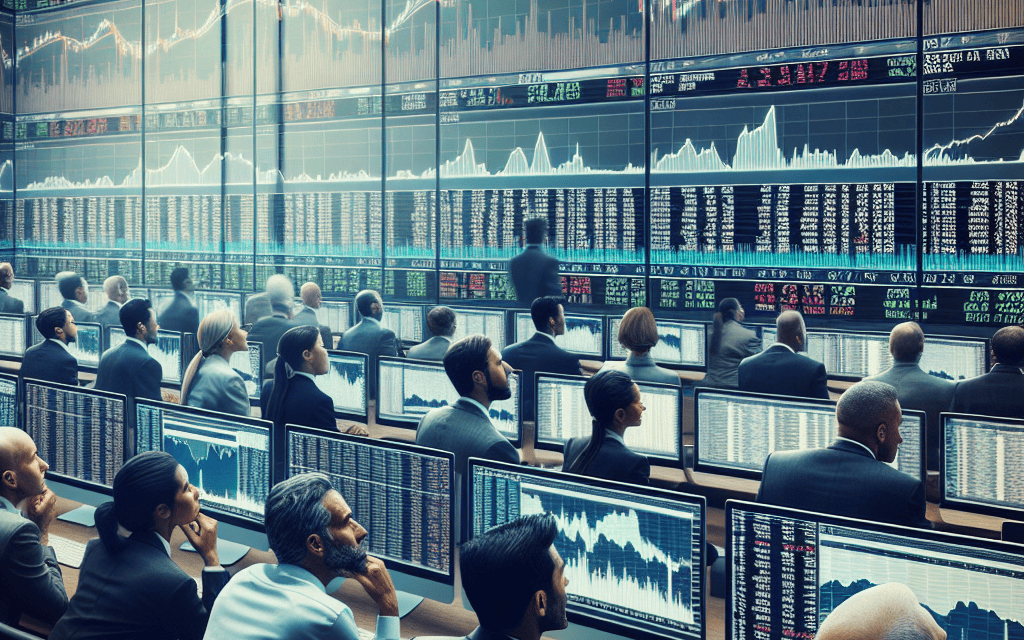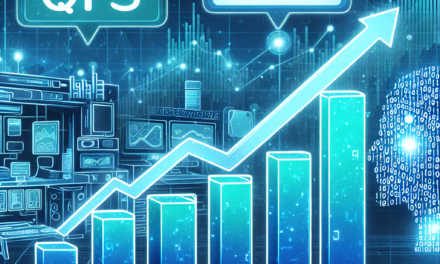“Steady Futures: Wall Street Holds Its Breath for Election Day Outcomes”
Introduction
Futures markets remained steady as Wall Street braced for the impending U.S. Election Day, reflecting a cautious sentiment among investors. With the political landscape poised for potential shifts, market participants are closely monitoring developments that could influence economic policies and regulatory frameworks. The stability in futures suggests a wait-and-see approach, as traders and investors assess the possible outcomes and their implications for financial markets. This period of anticipation underscores the critical intersection of politics and economics, with the election results expected to have significant ramifications for market dynamics and investor strategies.
Impact Of U.S. Elections On Futures Markets
As the United States approaches another pivotal election day, the financial markets are poised in anticipation, with futures trading reflecting a sense of cautious stability. The impact of U.S. elections on futures markets is a subject of considerable interest and analysis, as investors and traders alike seek to navigate the uncertainties and potential shifts in policy that accompany a change in political leadership. Historically, election periods have been characterized by heightened volatility, as market participants attempt to price in the possible outcomes and their implications for economic policy, regulatory changes, and fiscal strategies.
In the lead-up to election day, futures markets often exhibit a steadying effect, as traders adopt a wait-and-see approach. This phenomenon can be attributed to the inherent uncertainty surrounding election results and the subsequent policy directions that may be pursued by the incoming administration. Investors tend to exercise caution, refraining from making significant moves until a clearer picture emerges. Consequently, futures markets may experience reduced trading volumes and narrower price ranges, reflecting a collective pause as market participants await the resolution of electoral uncertainties.
Moreover, the impact of U.S. elections on futures markets is not confined to domestic considerations alone. Given the interconnected nature of the global economy, international investors also closely monitor U.S. elections, as the outcomes can have far-reaching implications for global trade, diplomatic relations, and international financial markets. The policies of the U.S. government, particularly in areas such as trade agreements, tariffs, and foreign relations, can significantly influence global economic dynamics. As such, futures markets worldwide may exhibit a degree of sensitivity to U.S. election outcomes, with potential ripple effects across various asset classes.
In addition to the immediate reactions to election results, futures markets are also influenced by the anticipated policy shifts that may occur under a new administration. For instance, changes in fiscal policy, such as tax reforms or infrastructure spending initiatives, can have a direct impact on economic growth prospects and, consequently, on market sentiment. Similarly, regulatory changes in sectors such as finance, healthcare, and energy can lead to adjustments in market valuations and investor strategies. As traders assess the potential policy directions of the incoming administration, futures markets may experience shifts in sentiment and positioning, reflecting the evolving expectations of market participants.
Furthermore, the role of central banks, particularly the Federal Reserve, is another critical factor that intersects with the impact of U.S. elections on futures markets. The Federal Reserve’s monetary policy decisions, including interest rate adjustments and quantitative easing measures, are closely watched by market participants. The election outcomes can influence the Federal Reserve’s policy stance, as different administrations may have varying perspectives on monetary policy and its role in supporting economic growth. Consequently, futures markets may react to perceived changes in the Federal Reserve’s policy trajectory, adding another layer of complexity to the market dynamics surrounding U.S. elections.
In conclusion, the impact of U.S. elections on futures markets is multifaceted, encompassing domestic and international considerations, anticipated policy shifts, and the interplay with central bank actions. As election day approaches, futures markets often exhibit a steadying effect, reflecting the cautious stance adopted by market participants in the face of uncertainty. While the immediate reactions to election outcomes can lead to volatility, the longer-term implications of policy changes and economic strategies will continue to shape futures markets in the months and years following the election. As such, investors and traders remain vigilant, seeking to navigate the complexities of the electoral landscape and its impact on financial markets.
Historical Trends: Futures Stability During Election Periods
As the United States approaches another pivotal election day, the financial markets are once again under the microscope, with investors keenly observing the behavior of futures. Historically, futures markets have exhibited a tendency towards stability during election periods, a phenomenon that can be attributed to a variety of factors. Understanding these historical trends provides valuable insights into the dynamics of market behavior in the face of political uncertainty.
To begin with, it is essential to recognize that futures markets are inherently forward-looking, reflecting investors’ expectations about the future. During election periods, these expectations are often clouded by uncertainty regarding potential policy changes and their implications for the economy. However, despite this uncertainty, futures markets have shown a remarkable ability to maintain stability. This stability can be partly explained by the fact that investors tend to adopt a wait-and-see approach, refraining from making significant moves until the election results are clear. Consequently, trading volumes may decrease, leading to less volatility in the markets.
Moreover, historical data suggests that futures markets have often priced in potential election outcomes well in advance. This preemptive pricing is facilitated by the extensive analysis and polling data available to investors, allowing them to anticipate possible scenarios and adjust their positions accordingly. As a result, by the time election day arrives, much of the uncertainty has already been factored into the market, contributing to its steadiness.
In addition to these factors, it is important to consider the role of institutional investors in maintaining market stability during election periods. These investors, who often have a long-term investment horizon, are less likely to be swayed by short-term political developments. Their presence in the market provides a stabilizing force, as they are more inclined to focus on fundamental economic indicators rather than transient political events. This long-term perspective helps to anchor the market, preventing excessive volatility.
Furthermore, the presence of hedging strategies also plays a crucial role in ensuring futures market stability during elections. Investors often employ hedging techniques to mitigate potential risks associated with political uncertainty. By using derivatives and other financial instruments, they can protect their portfolios against adverse market movements, thereby reducing the likelihood of panic-driven trading. This widespread use of hedging strategies contributes to a more stable market environment, as it dampens the impact of sudden shifts in investor sentiment.
It is also worth noting that the global nature of financial markets adds another layer of complexity to the dynamics of futures stability during U.S. election periods. International investors, who closely monitor U.S. political developments, may also influence market behavior. However, their impact is often moderated by the interconnectedness of global markets, which tends to diffuse localized political risks across a broader spectrum of assets. This interconnectedness can act as a buffer, further enhancing market stability.
In conclusion, the historical trends of futures stability during U.S. election periods can be attributed to a combination of factors, including the forward-looking nature of futures markets, the influence of institutional investors, the use of hedging strategies, and the global interconnectedness of financial markets. While political uncertainty is an inherent aspect of elections, these factors collectively contribute to a steadying effect on futures markets, allowing them to navigate the complexities of election periods with relative calm. As Wall Street awaits the outcome of yet another election, these historical insights provide a reassuring perspective on the resilience of futures markets in the face of political change.
Investor Sentiment: How Elections Influence Market Behavior
Investor sentiment plays a crucial role in shaping market behavior, particularly during significant political events such as U.S. elections. As Wall Street braces for Election Day, futures markets often exhibit a steadying effect, reflecting a complex interplay of anticipation, uncertainty, and strategic positioning by investors. Understanding how elections influence market behavior requires an examination of the underlying factors that drive investor sentiment and the subsequent impact on financial markets.
Historically, elections have been periods of heightened volatility in the markets, as investors grapple with the potential implications of policy changes that may arise from a shift in political power. The anticipation of new fiscal policies, regulatory adjustments, and international trade agreements can lead to fluctuations in stock prices, bond yields, and currency values. However, as Election Day approaches, futures markets tend to stabilize, suggesting that investors are cautiously optimistic or have already priced in potential outcomes.
One reason for this stabilization is the market’s ability to adapt to uncertainty. Investors often engage in strategic hedging, using futures contracts to mitigate potential risks associated with election outcomes. By locking in prices for future transactions, they can protect their portfolios against adverse market movements. This hedging activity contributes to a more balanced market environment, as it reduces the likelihood of extreme price swings.
Moreover, the steadying of futures markets can be attributed to the dissemination of information and the role of media in shaping investor expectations. As Election Day nears, polls, expert analyses, and historical data provide investors with insights into potential election results. This information allows market participants to make informed decisions, reducing the element of surprise and fostering a sense of preparedness. Consequently, the market’s reaction to election outcomes is often more measured than anticipated.
In addition to hedging and information dissemination, the behavior of institutional investors also plays a significant role in stabilizing futures markets. These large-scale investors, such as mutual funds, pension funds, and hedge funds, possess the resources and expertise to navigate political uncertainties effectively. Their investment strategies often involve diversifying portfolios across various asset classes and geographic regions, thereby minimizing exposure to election-related risks. As these institutional investors adjust their positions in anticipation of Election Day, their actions contribute to a more stable market environment.
Furthermore, the global nature of financial markets means that U.S. elections have far-reaching implications beyond domestic borders. International investors closely monitor U.S. political developments, as changes in American policies can influence global trade, economic growth, and geopolitical stability. The interconnectedness of global markets means that investor sentiment is not confined to Wall Street alone but resonates across financial centers worldwide. This global perspective adds another layer of complexity to market behavior during election periods.
In conclusion, the steadying of futures markets as Wall Street awaits U.S. Election Day reflects a multifaceted interplay of investor sentiment, strategic positioning, and information dissemination. While elections inherently introduce uncertainty, the ability of markets to adapt and stabilize underscores the resilience and sophistication of modern financial systems. As investors navigate the complexities of political transitions, their actions and expectations shape market behavior, ultimately influencing the broader economic landscape. Understanding these dynamics is essential for investors seeking to make informed decisions in an ever-evolving political and economic environment.
Strategies For Trading Futures Amid Political Uncertainty

As the U.S. Election Day approaches, traders and investors find themselves navigating a landscape marked by heightened political uncertainty. This period often brings volatility to financial markets, particularly in futures trading, where the stakes are high and the potential for rapid shifts in market sentiment is ever-present. Understanding strategies for trading futures amid such uncertainty is crucial for market participants seeking to mitigate risks and capitalize on opportunities.
One of the primary strategies employed by traders during politically uncertain times is hedging. Hedging involves taking positions in futures contracts to offset potential losses in other investments. For instance, if an investor holds a portfolio of stocks that might be adversely affected by election outcomes, they might use futures contracts to hedge against potential declines. This approach allows traders to protect their portfolios from significant losses while maintaining exposure to potential gains.
In addition to hedging, diversification remains a key strategy. By spreading investments across various asset classes and sectors, traders can reduce the impact of adverse movements in any single market. During election periods, certain sectors may be more sensitive to political developments than others. For example, healthcare and energy sectors often experience heightened volatility due to policy changes proposed by different political parties. By diversifying their portfolios, traders can balance the risks associated with these sectors against more stable investments.
Moreover, maintaining a focus on technical analysis can provide valuable insights during times of political uncertainty. Technical analysis involves studying price charts and patterns to predict future market movements. By identifying key support and resistance levels, traders can make informed decisions about entry and exit points for their futures contracts. This approach is particularly useful when fundamental analysis becomes challenging due to the unpredictable nature of political events.
Furthermore, traders should remain vigilant about news and developments related to the election. Staying informed about polling data, policy proposals, and potential election outcomes can help traders anticipate market reactions. However, it is essential to approach such information with caution, as markets can react unpredictably to news, and sentiment can shift rapidly. Therefore, traders should be prepared to adjust their strategies as new information becomes available.
Another important consideration is the use of stop-loss orders. These orders automatically sell a futures contract when it reaches a predetermined price, limiting potential losses. In volatile markets, stop-loss orders can be an effective tool for managing risk, ensuring that traders do not suffer significant losses due to sudden market movements. By setting appropriate stop-loss levels, traders can protect their capital while allowing for potential gains.
Finally, maintaining a disciplined approach to trading is crucial. Emotional decision-making can lead to impulsive trades and increased risk exposure. By adhering to a well-defined trading plan and sticking to predetermined risk management strategies, traders can navigate the uncertainties of election periods with greater confidence.
In conclusion, trading futures amid political uncertainty requires a combination of strategies, including hedging, diversification, technical analysis, and disciplined risk management. By staying informed and maintaining a flexible approach, traders can effectively manage the challenges and opportunities presented by the U.S. Election Day. As markets remain steady in anticipation of the election, employing these strategies can help traders navigate the complexities of futures trading during this critical period.
Analyzing Wall Street’s Reaction To Election Outcomes
As the United States approaches another pivotal election day, Wall Street finds itself in a state of cautious anticipation. The financial markets, often sensitive to political developments, are currently exhibiting a steady demeanor, reflecting a collective pause as investors await the outcomes that could shape economic policies and regulatory landscapes. This period of relative calm in the futures market is not unusual; rather, it underscores the market’s inherent tendency to brace for potential shifts in the political and economic environment.
Historically, U.S. elections have had a significant impact on market behavior, with investors closely monitoring the potential implications of electoral outcomes on fiscal policies, trade agreements, and regulatory frameworks. The anticipation surrounding election day is palpable, as market participants attempt to gauge the possible trajectories of economic policy under different political leaderships. This year is no exception, with futures markets maintaining a steady course as traders and investors alike weigh the potential consequences of the election results.
In the lead-up to election day, market analysts often engage in extensive scenario planning, considering various electoral outcomes and their potential impact on sectors such as healthcare, energy, and technology. The anticipation of policy shifts can lead to strategic positioning within portfolios, as investors seek to mitigate risks and capitalize on opportunities that may arise post-election. This strategic positioning is evident in the current stability of futures, as market participants exercise caution, opting to wait for clearer signals before making significant moves.
Moreover, the steady nature of futures markets can be attributed to the diverse range of factors that investors must consider during election periods. Beyond the immediate political landscape, global economic conditions, interest rates, and geopolitical tensions also play crucial roles in shaping market sentiment. As such, the interplay between domestic political developments and broader economic indicators creates a complex environment for investors, necessitating a balanced approach to risk management.
In addition to the direct impact of election outcomes on specific sectors, the overall market sentiment is also influenced by the perceived stability and predictability of the political environment. A clear and decisive election result can provide a sense of certainty, potentially leading to increased investor confidence and market activity. Conversely, prolonged uncertainty or contested results may contribute to heightened volatility, as markets react to the lack of clarity regarding future policy directions.
As election day approaches, it is essential for investors to remain vigilant, keeping a close eye on both domestic and international developments that could influence market dynamics. While the current steadiness in futures markets suggests a wait-and-see approach, the potential for rapid shifts in sentiment remains ever-present. In this context, maintaining a diversified portfolio and staying informed about evolving political and economic landscapes are prudent strategies for navigating the uncertainties inherent in election periods.
In conclusion, as Wall Street awaits the outcomes of the U.S. election, the steady nature of futures markets reflects a broader sense of anticipation and caution among investors. The interplay between political developments and market behavior underscores the importance of strategic planning and risk management in navigating the complexities of election periods. As the results unfold, the financial markets will undoubtedly respond, providing valuable insights into the evolving relationship between politics and economics.
The Role Of Futures In Hedging Against Election Volatility
As the United States approaches another pivotal election day, the financial markets are poised for potential volatility, a common occurrence during such significant political events. In this context, futures contracts emerge as a crucial tool for investors seeking to hedge against the uncertainties that elections often bring. These financial instruments allow market participants to lock in prices for assets at a future date, thereby providing a mechanism to manage risk and stabilize portfolios amidst the unpredictability of election outcomes.
Futures contracts, by their very nature, offer a way to speculate on the direction of market movements without the need to own the underlying asset. This characteristic makes them particularly appealing during election periods when market sentiment can swing dramatically based on polling data, debates, and other political developments. Investors and traders use futures to express their views on how they believe the election results will impact various sectors, from technology and healthcare to energy and finance. By doing so, they can position themselves to benefit from anticipated market trends or protect their investments from adverse movements.
Moreover, the role of futures in hedging against election volatility is underscored by their ability to provide liquidity and price discovery. As election day approaches, the volume of futures trading typically increases, reflecting heightened interest and activity among market participants. This surge in trading not only enhances liquidity but also contributes to more efficient price discovery, as the collective actions of traders help to establish market expectations regarding the election’s impact. Consequently, futures markets become a barometer of investor sentiment, offering insights into how different scenarios might unfold.
In addition to their hedging capabilities, futures contracts also serve as a valuable tool for portfolio diversification. By incorporating futures into their investment strategies, investors can gain exposure to a wide range of asset classes, including commodities, currencies, and indices. This diversification can help mitigate the risks associated with election-induced volatility, as it reduces reliance on any single asset or market segment. For instance, an investor concerned about potential fluctuations in the stock market might use futures to gain exposure to gold or other commodities, which often behave differently in times of political uncertainty.
Furthermore, the use of futures in hedging against election volatility is not limited to institutional investors. Retail investors, too, can benefit from these instruments, provided they have a clear understanding of the risks and mechanics involved. With the advent of online trading platforms and educational resources, access to futures markets has become more democratized, enabling a broader range of investors to participate in hedging strategies. However, it is essential for all investors to approach futures trading with caution, as the leverage inherent in these contracts can amplify both gains and losses.
In conclusion, as Wall Street braces for the potential market turbulence that U.S. elections can bring, futures contracts stand out as a vital tool for managing risk and navigating uncertainty. By offering a means to hedge against volatility, provide liquidity, and facilitate diversification, futures play an indispensable role in helping investors maintain stability in their portfolios. As election day draws near, the steadying influence of futures will undoubtedly be a focal point for market participants seeking to safeguard their investments against the unpredictable nature of political change.
Comparing Futures Performance In Past U.S. Elections
As the United States approaches another pivotal election day, the financial markets are poised in anticipation, with futures trading reflecting a sense of cautious optimism. Historically, the performance of futures around U.S. elections has been a subject of keen interest for investors, analysts, and policymakers alike. Understanding the trends and patterns that have emerged in past election cycles can provide valuable insights into what might be expected this time around.
In examining the performance of futures during previous U.S. elections, it is essential to consider the broader economic and political context of each period. For instance, during the 2008 election, the financial crisis was at its peak, leading to heightened volatility in the markets. Futures, in this case, were significantly impacted by the uncertainty surrounding the economic policies of the incoming administration. Conversely, the 2016 election saw futures initially plummet in response to unexpected results, only to recover swiftly as investors recalibrated their expectations based on anticipated policy shifts.
Transitioning to more recent elections, the 2020 cycle was marked by the unprecedented challenges of the COVID-19 pandemic. The futures market, during this period, was influenced not only by the electoral outcomes but also by the broader economic disruptions caused by the global health crisis. The interplay between pandemic-related economic policies and election results created a complex environment for futures trading, with investors closely monitoring both domestic and international developments.
As we approach the current election, it is crucial to recognize the factors that are likely to influence futures performance. Economic indicators such as inflation rates, employment figures, and GDP growth will undoubtedly play a significant role. Additionally, the geopolitical landscape, including trade relations and international conflicts, can also impact market sentiment. Investors are particularly attentive to the potential policy changes that could arise from the election, especially in areas such as taxation, regulation, and government spending.
Moreover, the role of technology and social media in shaping public perception and market reactions cannot be underestimated. In recent years, the rapid dissemination of information and the influence of digital platforms have added a new dimension to how futures markets respond to political events. This dynamic environment requires investors to be more agile and informed than ever before.
In comparing futures performance across different election cycles, it is evident that while each period has its unique characteristics, certain patterns tend to recur. Typically, markets exhibit a degree of volatility leading up to the election as uncertainty looms. However, once the results are clear, there is often a period of adjustment as investors digest the implications of the new political landscape. This adjustment phase can lead to either stabilization or further volatility, depending on the perceived impact of the election outcomes on economic policies.
In conclusion, as Wall Street awaits the results of the upcoming U.S. election, the futures market remains steady, reflecting a blend of caution and anticipation. By analyzing past election cycles, investors can gain a better understanding of potential market movements and prepare for the various scenarios that may unfold. While history provides valuable lessons, the unique circumstances of each election mean that adaptability and vigilance are key to navigating the complexities of futures trading during these critical periods.
Q&A
1. **What are futures?**
Futures are financial contracts obligating the buyer to purchase, or the seller to sell, an asset at a predetermined future date and price.
2. **Why are futures steady before an election?**
Futures may remain steady before an election due to market participants adopting a wait-and-see approach, minimizing risk until the election outcome is clearer.
3. **How does the U.S. election impact Wall Street?**
The U.S. election can impact Wall Street by influencing investor sentiment, regulatory expectations, and potential changes in fiscal and economic policies.
4. **What sectors are most affected by election outcomes?**
Sectors such as healthcare, energy, and finance are often most affected due to differing policy priorities between political parties.
5. **How do investors typically react to election uncertainty?**
Investors may react to election uncertainty by reducing exposure to riskier assets, increasing cash holdings, or diversifying their portfolios.
6. **What strategies do traders use during election periods?**
Traders might use strategies such as hedging with options, focusing on defensive stocks, or employing technical analysis to navigate volatility.
7. **What historical trends are observed in markets during elections?**
Historically, markets may experience increased volatility during elections, but they often stabilize once the results are clear and policies are better understood.
Conclusion
As U.S. Election Day approaches, futures markets remain steady, reflecting a cautious sentiment among investors. This stability suggests that market participants are in a wait-and-see mode, anticipating potential volatility depending on the election outcomes. The steadiness in futures indicates that while there is uncertainty, there is also a level of preparedness among investors for various scenarios. Overall, the market’s current posture underscores the importance of the election’s results on future economic and policy directions, with investors poised to react once more information becomes available.





